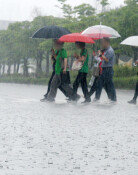Infrared Cameras Installed All Over Airports
Infrared Cameras Installed All Over Airports
Posted May. 04, 2003 22:08,
Authorities have decided to supply 10 portable infrared camera units to major quarantine stations from May 5 if possible, in order to reinforce the quarantine inspection of SARS (Severe Acute Respiratory Syndrome) on the inbound travelers upon entrance to the country.
We will provide quarantine stations with 10 infrared cameras, 8 of 10 will be provided to Incheon International Airport, 1 unit to the Port of Incheon and the Busan quarantine station each so that inspectors may immediately go on board an aircraft or ship as soon as it arrives and find sick passengers and flight attendants with high fever.
Infrared cameras will be provided to Incheon International Airport first. When patients with high fever more than 30 degrees Celsius are found, quarantine inspectors will show them to a separate gate and put them through quarantine inspection and testing. In this way, inspectors may know which possible infections are truly SARS.
The National Institute of Health (NIH) classified one male student in his pre-teens as a patient suspected of SARS and hospitalized him on May 3 because of the symptoms of high fever and cough displayed from May 2. He entered through Incheon International Airport on April 27 coming from a long stay in Jirin-seong, China.
So far patients suspected of SARS are 15 in total, and 3 of them are in the hospital. Even though a man was proven to be normal after taking chest X-ray examinations, NIH is continuing with detailed examinations of the student. The NIH is also detaining his family at home; they were returned with him from China. The NIH is also trying to track down passengers on board the same flight as the patient.
Health professionals anticipate that the spread of SARS is limited in Korea, as the increasing rate of patients suspected of SARS apparently has reduced. In particular, there has been a reduction of inbound travelers from China, decreasing 20 to 25% of peak numbers.
Korean residents and students studying abroad in China number 35,000 people. And it seems that approximately 40% of them have returned to Korea by May 4. The NIH added, We guess that most people who entered the country, seeing the reservation rate on flights sharply drop this week.
Recently the new SARS cases in Hong Kong and Beijing, China have reduced. This is another factor that has contributed to decreasing the possibility of the influx of SARS to Korea.
Because symptoms in Korea usually appear later, approximately 1 week, than in China, we cannot jump to any conclusions at this moment, announced NIH Director Kim Moon-sik. In particular, the possibility of SARS still remains for people who already entered from a SARS hotspot.
Jin Lee leej@donga.com
Headline News
- 55%of SNU Hospital professors start indefinite suspension from today
- DP intends to complete the composition of National Assembly this week
- Too high bonus for head of reconstruction associations causes controversy
- 13 infectious diseases sharply increase across the world
- International Skating Union revises major rules







